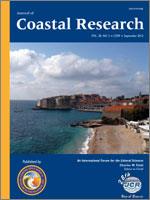Zhao, M.; Yu, K.; Zhang, Q.; Shi, Q., and Price, G.J., 2012. Long-term decline of a fringing coral reef in the northern South China Sea.
The Luhuitou coral reef is a fringing reef at Hainan Island in the northern South China Sea. Since the 1960s, the reef has experienced several significant ecological changes. During that interval, the mean coral cover decreased dramatically from 80–90% in 1962–65 and to just 12% in 2009. In the 1960s, the coral community structure was divided into three well-defined zones: a Goniastrea zone and Montipora zone (both on the reef flat) and an Acropora zone (on the reef slope). However, by 2009, Porites lutea became the dominant species on the reef flat, whereas the predominance of Acropora on the reef slope weakened significantly. There are few long-established Porites lutea colonies present, with approximately 80% being younger than 30 years old. This demographic pattern differs significantly from healthy coral reefs, which are typically dominated by large, well-established (and mature) coral colonies. The long-term decline of the Luhuitou coral reef has most likely been driven as a result of anthropogenic activities, such as overfishing, destructive fishing, reef rock digging, and mariculture and tourism activities. Our study reinforces previous works and highlights the vulnerability of coral reefs to anthropogenic impacts.






